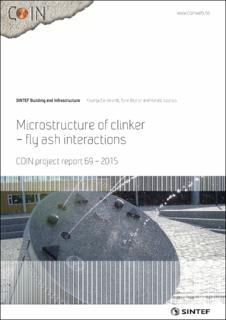Microstructure of clinker – fly ash interactions
Research report
Published version
Permanent lenke
https://hdl.handle.net/11250/2826650Utgivelsesdato
2015Metadata
Vis full innførselSamlinger
- COIN Project report [76]
- Publikasjoner fra CRIStin - SINTEF AS [5801]
- Rapporter fra SINTEF Community [790]
- SINTEF Community [2247]
Sammendrag
The first objective was to find out why a white clinker from previous studies has a higher strength potential than the other 3 clinkers tested in the same study, as well as finding out whether or not it contains other aluminate compounds than C3A.
Clinker δ gives higher early strength than the other clinkers because it contains anhydrite as flux and therefore has a total higher calcium sulphate content than the other cements when the same amount of gypsum is added to the clinkers.
Clinker δ also has a higher C3A content (≈ 6%) than predicted from the Rietveld analysis and part of it probably as a glassy XRD amorphous phase with some fluorine.
Clinker δ only has a marginally higher surface than the other clinkers, but substantially higher C3S content that will add to the higher early strength together with excess calcium sulphate not bound early by C3A being able to help accelerate C3S hydration.
The other clinkers also contained substantially amounts of C4AF that has a slow hydration with large amounts remaining unhydrated at 28 days.
The second objective was to find out why one particular ash out of 4 tested gave much higher strength than the others when replacing cement (clinker with gypsum) in mortars.
Fly ash D is not a real fly ash, but a fluidized bed ash that consist of a much more open structure than the closed glassy, spherical particles of the other fly ashes. It also contains a lot more calcium oxide (17.9% CaO) than the other fly ashes (Fly ash B is the second highest with 7.1% CaO). Hence it is assumed to be more reactive than the other ashes.
Fly ash D also contains considerable more sulphate (6.6% as SO3) than the other fly ashes (fly ash B is the second highest with 0.5% SO3) which would lead to more ettringite formed on the expense of AFm resulting in more water bound and hence higher strength.
The higher sulphate content (and partly less aluminate) for fly ash D compared to the other fly ashes also leads to a less response of this fly ash to the synergy effect with limestone, since AFt is stabilized on the expense of AFm.
